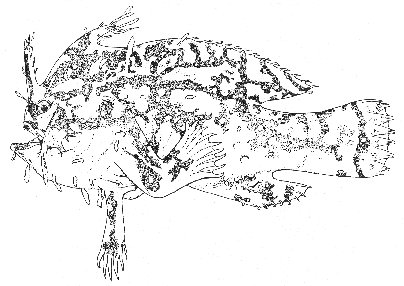Sargassum fish Histrio pictus (Cuvier and Valenciennes) 1837
MOUSEFISH
[Jordan and Evermann, 1896-1900, p. 2716, as Pterophryne histrio (Linnaeus) 1758.]
Description—
The peculiar armlike pectoral fins; the rather long fleshy ventral fins situated on the throat; the soft flabby skin; and a body flattened sidewise (about 2¾ times as long as it is deep) distinguish this fish from any other that is known from the Gulf of Maine, or that is ever likely to be found there. The goosefish (p. 532), the only one of its close relatives which normally inhabits the Gulf, is of such different appearance with its flattened body form, and enormous mouth, that it is not necessary to enumerate the smaller differences between the two.
The head and body of the sargassum fish appear as one, for each gill opening has the form of a pore on the lower margin of the pectoral near its base, so small that it is likely to be overlooked. There are three detached dorsal spines. The first, standing over the front margin of the eye, has the form of a slender tentacle, its tip bearing a bulbous swelling, known technically as an "illicium," which is fringed at the tip. The second spine (close behind the first) and the third are much larger than the first; they are enclosed in skin so thick that they suggest conical horns in their general appearance, and they bear several tags or streamers of skin. All the other fins are also fleshy. The second (soft-rayed) dorsal fin is more than twice as long as the anal fin; and the detached [page 542] tips of both the dorsal rays and the anal rays form short fringes. The margin of the caudal fin is almost straight. The skin feels smooth to the touch; actually it is finely studded with minute granulations, and it bears variously shaped fleshy tags, as appears in the illustration (fig. 287).
Color—
Creamy white, the fins as well as the head and body mottled with pale and dark brown. The fleshy tags are yellowish.
General range—
Tropical and subtropical, living at the surface among floating seaweed; sometimes drifting far northward with the Gulf Stream.
Occurrence in the Gulf of Maine—
A specimen about 4¾ inches (12 cm.) long, that was picked up in a purse seine near the surface over the west central part of Georges Bank, by the Schooner Old Glory on September 15, 1930,[92] and a second of 2¼ inches, taken off the southeast slope of Georges Bank, by the sword fisherman Leonora C, on June 15, 1937, are the only records of this fish in the Gulf of Maine; the most northerly records, in fact, for it for continental waters in this side of the Atlantic. But it has been picked up from time to time near Woods Hole.[93] Living, as they usually do, among floating gulf weed (Sargassum), it is not astonishing that sargassum fish should drift in over the offshore banks, occasionally.
